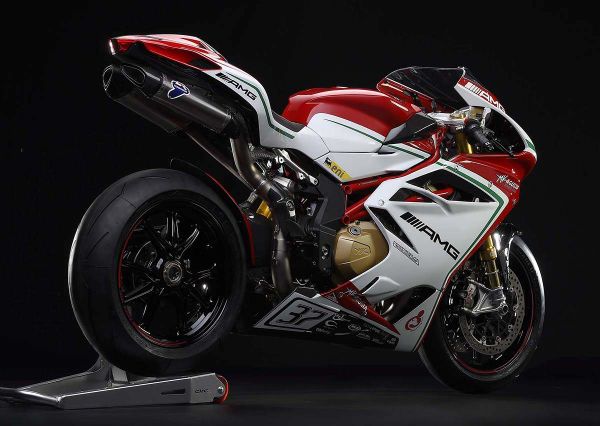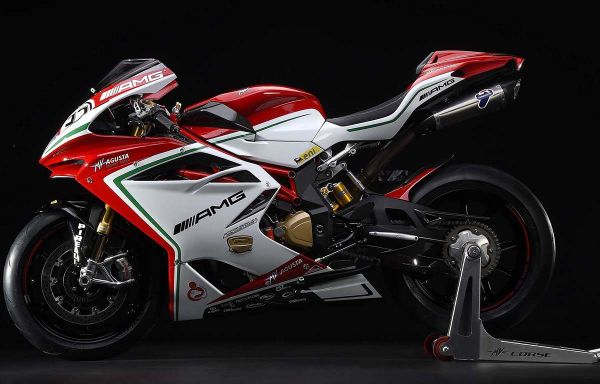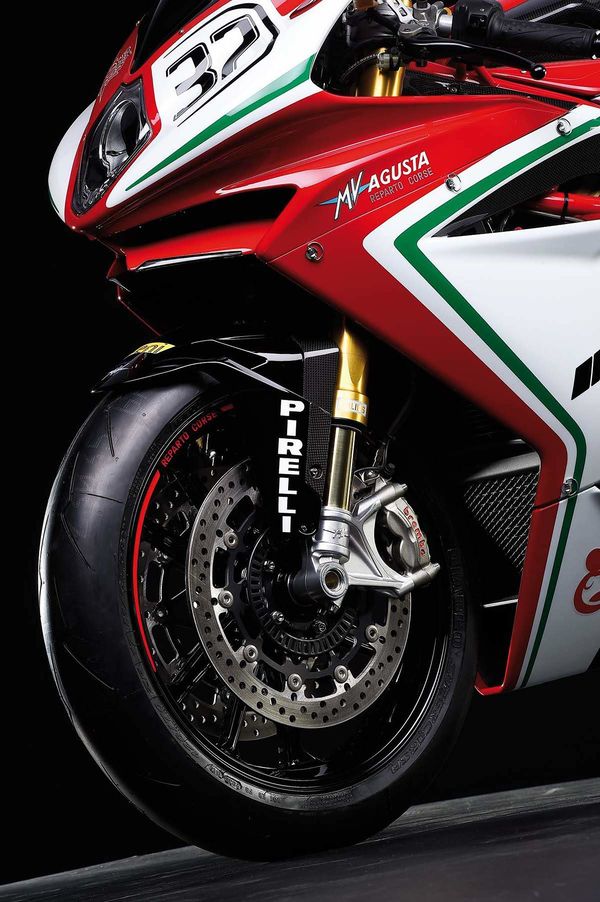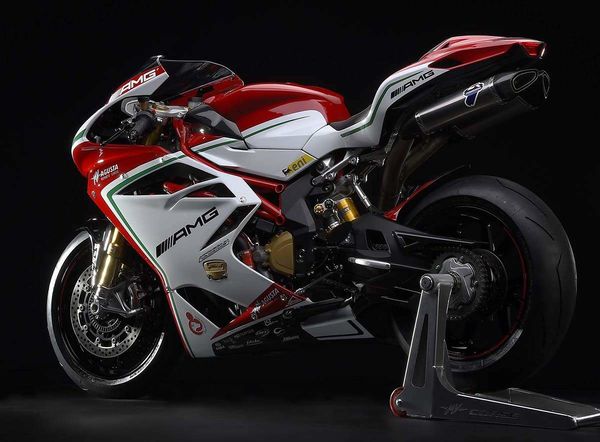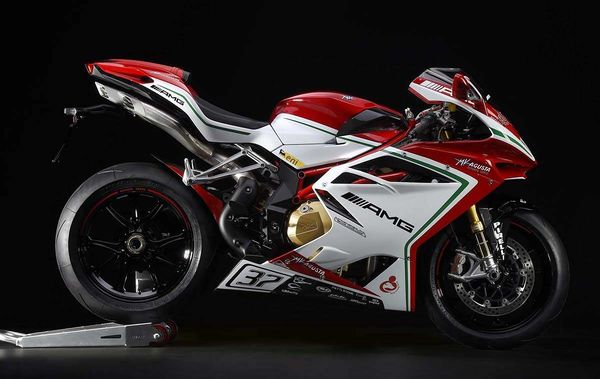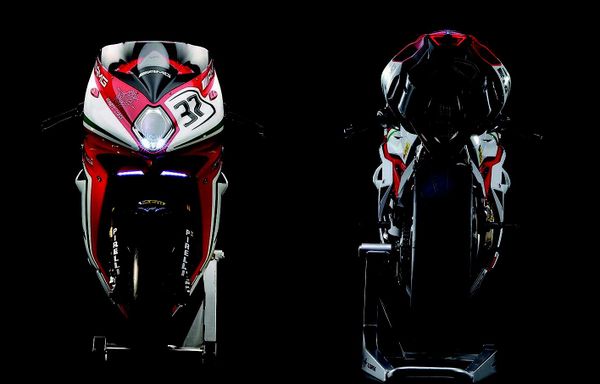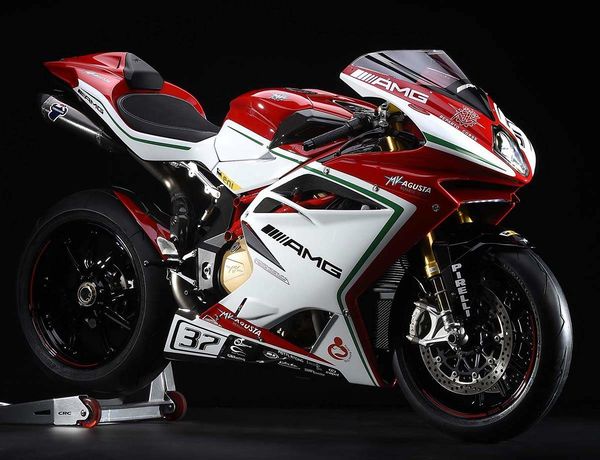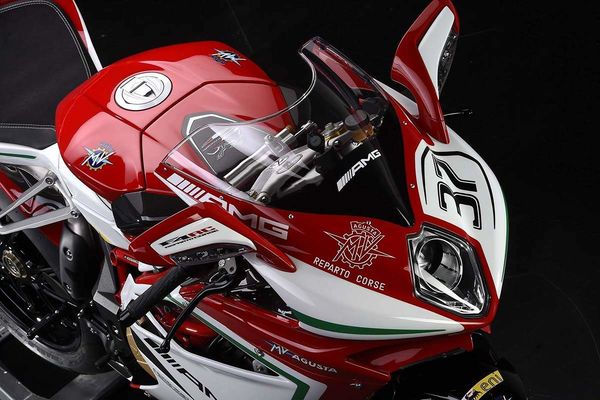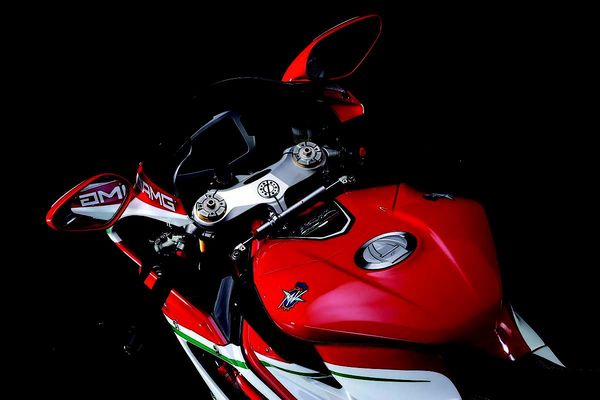MV Agusta F4RC
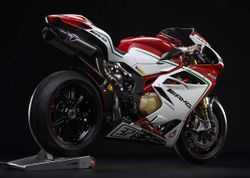 |
|
| MV Agusta F4RC | |
| Manufacturer | |
|---|---|
| Production | 250 Units |
| Engine | Four stroke, transverse four cylinder. DOHC, 4 radial valves per cylinder |
| Compression ratio | 13.4:1 |
| Battery | Li-po 12.8 V - 4.0 Ah |
| Transmission | Cassette style; six speed, constant mesh |
| Frame | Type CrMo Steel tubular trellis Rear swing arm pivot plates material is Aluminum alloy |
| Suspension | Front: 43 mm (1.69 in.) Öhlins USD front fork, NIX 30 type with TIN coating on inner tubes, left compression and right rebound manual adjustment, top out spring. Rear: Öhlins progressive, TTX36 twin tube rear shock absorber with piggyback resevoir, compression and rebound adjusted with anodized aluminum adjustment knobs Single sided swing arm material Aluminum alloy |
| Brakes | Front: 2x floating 320mm discs and aluminum flange, Front brake caliper Brembo radial-type, single-piece with 4 pistons Ø 34 mm (Ø 1.34 in.) Rear: Single 210mm disc Nissin with 4 pistons caliper |
| Front Tire | 120/70 ZR17 M/C (58 W) |
| Rear Tire | 200/55 ZR17 M/C (78 W) |
| Wheelbase | 1430 mm / 56.2 in |
| Seat Height | 830 mm / 2.6 in |
| Weight | 175 kg / 385.8 lbs (dry), |
| Fuel Capacity | 17 Liters / 4.4 US gal |
| Manuals | Service Manual |
Engine[edit | edit source]
The engine was a Cooling with separated liquid and oil radiators cooled Four stroke, transverse four cylinder. DOHC, 4 radial valves per cylinder. The engine featured a 13.4:1 compression ratio.
Drive[edit | edit source]
Power was moderated via the Wet, multi-disc with back torque limiting device and Brembo radial pump/lever assembly.
Chassis[edit | edit source]
It came with a 120/70 ZR17 M/C (58 W) front tire and a 200/55 ZR17 M/C (78 W) rear tire. Stopping was achieved via 2x floating 320mm discs and aluminum flange, Front brake caliper Brembo radial-type, single-piece with 4 pistons Ø 34 mm (Ø 1.34 in.) in the front and a Single 210mm disc Nissin with 4 pistons caliper in the rear. The front suspension was a 43 mm (1.69 in.) Öhlins USD front fork, NIX 30 type with TIN coating on inner tubes, left compression and right rebound manual adjustment, top out spring. while the rear was equipped with a Öhlins progressive, TTX36 twin tube rear shock absorber with piggyback resevoir, compression and rebound adjusted with anodized aluminum adjustment knobs Single sided swing arm material Aluminum alloy. The F4RC was fitted with a 17 Liters / 4.4 US gal fuel tank. The bike weighed just 175 kg / 385.8 lbs. The wheelbase was 1430 mm / 56.2 in long.
Photos[edit | edit source]
Overview[edit | edit source]
MV Agusta F4RC
All this, and much more, swathed in
the seductive, streamlined carbon fibre fairing of the most
powerful, fastest and hardest-hitting F4 ever built. Built to
race. To weave around Superbike racetracks. And ignite the
dreams of even the most demanding enthusiasts.
RC, Reparto Corse: every detail, even where of no apparent
significance, has been conceived, designed and built with the
sole purpose of providing maximum race competitiveness. And,
therefore, maximum road riding pleasure.
The new F4 RC is the sharp end of a project that began with the
first incredible F4. The model that put MV Agusta back in the
spotlight, changing the sports bike concept forever. Acclaimed,
coveted and loved by motorcyclists the world over.
A flawless blend of style and substance, this bike has gone from
strength to strength while remaining ever-faithful to the
panache and technology that make it so unique.
The culmination of that development is the F4 RC. Produced in a
limited edition of just 250 bikes, each F4 RC comes complete
with a certificate of authenticity and a comprehensive special
components kit that provides an awesome power peak of 212 hp at
13,600 rpm.
At the same time, this version, which
joins the standard and RR line-up, is gearing up for success in
the 2015 Superbike World Championship. Just approved race
regulations, in fact, drastically limit the modifications that
can be made to production models. Consequently, to have a bike
that will be extremely competitive right from the first world
championship race, technical specifications need to be defined
with near-manic attention to detail.
Exclusiveness is one of the distinguishing traits of the F4 RC.
A bike that is unique at first glance, thanks also to a great
choice of graphics and an eye-catching color scheme that
immediately marks it out as a thoroughbred. The striking livery
- evidently designed for the racetrack - features an
attentiongrabbing combination of color and trim that emphasises
the bike's instantly recognisable lines and exceptional
technical components. And those who want a color scheme
identical to that used on the bikes competing in the Superbike
World Championship need only choose their own personal race
number on the front and lower fairing. Performance and
lightness: the pursuit of these goals has been boundless, with
work being carried out on every component in every possible
area.
ENGINE
The 4-cylinder Corsa Corta engine with central timing chain and radial valves has undergone a series of modifications aimed at reducing the already-low overall weight and boosting performance. This compact power unit is characterised by a 79 mm bore and a 50.9 mm stroke. Hand-assembled to ensure optimisation of all components and maximum uniformity among the 250 F4 RC bikes that will be coming off the production line, each motorcycle features radial valves, a technical tradition that began with the very first F4 engine. Those same valves, both intake and exhaust, are each moved by a spring to reduce total moving masses and make it easier to achieve the extremely high RC-standard engine revs. Already redesigned for the most recent F4 version, the lubrication circuit ensures outstanding reliability whatever the riding conditions, even in the most demanding situations so typical of racing. In order to further reduce weight, MV Agusta has employed a series of components in magnesium alloy, a material used, most importantly, for the cylinder head cover yet also on the clutch, chain, removable gearboxselector, labyrinth blow-by, alternator, ABS pick up sump and lubricating filter and oil duct support flange covers. All-titanium bolts and screws, which have saved 1.1 kg, sharpen the personality of the F4 RC further, giving the technical content a decidedly racing flavour. And, as you'd expect from a real Superbike, the quest to lighten the machine has gone much further: pistons, rods, and crankshaft have all been designed to be as light as possible.
Meticulous work has been carried out on
all internal steel parts, including numerous gear components
and, of course, the camshafts, all of which have been given a
thorough overhaul using sophisticated machining tools to remove,
quite literally, every redundant gram.
The head features new intake and exhaust
ducts that, together with all the other changes, have increased
maximum power further to 205 hp at 13,450 rpm (212 hp on the kit
version with exhaust system and dedicated control unit) against
a torque of 115 Nm at 9300 rpm. As stated, the intake has been
modified by designing new ducts. The 50 mm throttle bodies have
been integrated in the TSS variable-length intake system. The
injectors are arranged on two banks: the upper one uses specific
Magneti Marelli components that offer high performance in terms
of fuel delivery; the lower bank instead features 4 Mikuni
injectors. To maximize efficiency, silicone cooling circuit
hoses have been employed.
ELECTRONICS
Electronic support is both complete and effective thanks to MVICS 2.0 (Motor & Vehicle Integrated Control System) technology, specifically developed by MV Agusta for all its models. The ELDOR electronic control unit manages the complete Ride-By-Wire system (with redundant circuits) and the 4 engine maps. There is also plenty of scope for parameter adjustment.
- throttle sensitivity - maximum torque - engine braking - engine response - rev limiter
The inertial platform with lean angle sensor uses three gyroscopes and three accelerometers, plus the ABS pick up ring, to gather all the data, which is then algorithm-processed to determine required traction control (which has an 8-level setting range and can also be disabled). The EAS 2.0 (Electronically Assisted Shift) system allows clutchless gear changes, speeding up shifts significantly and resulting in shorter lap times.
FRAME AND SUSPENSION
Throughout the history of the F4, the frame has played a vital role: devised to combine the advantages of different design solutions, its success gradually saw it extended to the entire MV Agusta range. On the F4 RC the CrMo tubular steel trellis frame is TIG-welded by hand; the lower part is finished off with aluminum alloy plates on which a seat has been machined to insert the singleside swingarm pin, the fulcrum of which can be height-adjusted. Compared to the F4 RR, basic measurements remain unaltered: 1,430 mm wheelbase, steering head angle (23.5°) and single-sided swingarm length (565 mm).
The choice of suspension set-up shows the
extent to which the F4 RC has been inspired by racing - and
built to race. Fork, rear shock and steering damper are, in
fact, mechanical instead of electronic : more detail is , the
front fork is a TiN-coated Ohlins USD NIX 30 with separate
hydraulic adjustment of compression (left stanchion) and rebound
(right stanchion), plus spring pre-load adjustment. At the rear
there is an Ohlins TTX 36 shock absorber with piggyback
reservoir: manual compression/rebound adjustment is effected via
the anodised aluminum knobs. Similarly, the steering damper,
also made by Ohlins, can be mechanically adjusted too. Thanks to
the absence of the control unit and actuators needed on
electronically controlled suspension, the weight of the F4 RC
has been reduced even further.
The unique components of this version are further highlighted by
widespread adoption of carbon fibre on the side panels, lower
fairing, rear mudguard and front mudguard spoiler, upper and
lower chain guard, the upper airbox section and the left and
right intake covers.
Made of forged aluminum alloy, the wheels have been designed
and built exclusively for this model. Even the battery - a light
lithium (Li-Po) 12.8 V 4 Ah unit - is model-specific. Foot
controls are also new: peg positions are adjustable and the
shift lever features a sensor for fast gear changes.
BRAKES
The braking system confirms the degree of excellence seen on the F4 RR: a pair of 320 mm front discs with steel braking rotors and monobloc Brembo M50 callipers with dedicated radial pump provide unbeatable performance, weight and stiffness. At the rear a 4-piston caliper and 210 mm disc are mounted. WEIGHT AND KIT
To see just how exclusive the new F4 RC is, just take a look at the figures: to start with, it weighs a full 7 kg less than the F4 RR. And that's not all: the price includes a complete track riding kit which cuts weight by another 6 kg, pushing total weight savings up to an impressive 13 kg. With the assembly of specific components, such as the titanium Termignoni exhaust system with dedicated control unit, the bike reaches an exceptionally high maximum power of 212 hp at 13600 rpm.
The kit includes:
- Termignoni exhaust system in titanium, with carbon fibre heat guard; - dedicated control unit; - carbon fibre rear seat cowl for single-seater use; - quick-release tank cap; - red anodized Ergal plugs to be applied after removal of rear view mirrors; - certification demonstrating that each motorcycle belongs to a limited edition of just 250 units - personalised motorcycle cover COLOR AND PRICE
The new F4 RC is limited to 250 units and each is numbered and supplied with a certificate, the bike includes a "ready to race" component kit with everything needed to configure the bike to be used exclusively on race circuits.
F4 RC
- WITH ABS BOSCH 9 PLUS RACE - RLM (REAR WHEEL LIFT-UP MITIGATION) - EAS 2.0 Source
| Make Model | MV Agusta F4RC |
|---|---|
| Year | 2015 - 16 |
| Production | 250 Units |
| Engine Type | Four stroke, transverse four cylinder. DOHC, 4 radial valves per cylinder |
| Displacement | 998 cc / 60.9 cu-in |
| Bore X Stroke | 79 x 50.9 mm |
| Compression | 13.4:1 |
| Cooling System | Cooling with separated liquid and oil radiators |
| Lubrication | Wet sump |
| Engine Management | Integrated ignition - injection system MVICS (Motor & Vehicle Integrated Control System) with eight injectors (4 lower fuel injectors by Mikuni + 4 upper fuel injectors by Magneti Marelli with increased fuel flow). Engine control unit Eldor EM2.0, throttle body full drive by wire Mikuni, pencil-coil with ion-sensing technology, control of detonation and misfire - Torque control with four maps, Traction Control with eight levels of intervention with lean angle sensor - TSS Torque Shift System employing variable length intake runners |
| Electronically | Assisted Shift - TSS Torque Shift System employing variable length intake runners |
| Alternator | 350 W at 5000 r.p.m. |
| Battery | Li-po 12.8 V - 4.0 Ah |
| Starting | Electric |
| Max Power Crankshaft | 158.0 kW / 212 hp @ 13600 rpm |
| Max Power | 151.0 kW / 205 hp @ 13450 rpm |
| Max Torque | 115.0 Nm / 11.7 kgm @ 9300 rpm |
| Clutch | Wet, multi-disc with back torque limiting device and Brembo radial pump/lever assembly |
| Electronic Quick-shift | MV EAS 2.0 (Electronically Assisted Shift) |
| Transmission | Cassette style; six speed, constant mesh |
| Final Drive | Chain |
| Primary Drive | 48/82 |
| Gear Ratio | 1st 14/37 2nd 16/33 3rd 18/31 4th: 20/30 5th 22/29 6th 21/25 |
| Final Drive Ratio | 15/41 |
| Frame | Type CrMo Steel tubular trellis Rear swing arm pivot plates material is Aluminum alloy |
| Steering Damper | Öhlins linear telescopic, manual adjustment |
| Front Suspension | 43 mm (1.69 in.) Öhlins USD front fork, NIX 30 type with TIN coating on inner tubes, left compression and right rebound manual adjustment, top out spring. |
| Front Wheel Travel | 124 mm / 4.72 in |
| Rear Suspension | Öhlins progressive, TTX36 twin tube rear shock absorber with piggyback resevoir, compression and rebound adjusted with anodized aluminum adjustment knobs Single sided swing arm material Aluminum alloy |
| Rear Wheel Travel | 120 mm / 4.72 in |
| Front Brakes | 2x floating 320mm discs and aluminum flange, Front brake caliper Brembo radial-type, single-piece with 4 pistons Ø 34 mm (Ø 1.34 in.) |
| Rear Brakes | Single 210mm disc Nissin with 4 pistons caliper |
| Abs | Bosch 9 Plus with Race Mode and RLM (Rear wheel Lift-up Mitigation) |
| Rim Front | Aluminum alloy 3,50 in x 17 in |
| Rim Rear | Aluminum alloy 6,00 in x 17 in |
| Front Tire | 120/70 ZR17 M/C (58 W) |
| Rear Tire | 200/55 ZR17 M/C (78 W) |
| Material | Carbon fiber and thermoplastic |
| Dimensions | Length 2115 mm / 83.3 in Width 750 mm / 29.5 in |
| Wheelbase | 1430 mm / 56.2 in |
| Seat Height | 830 mm / 2.6 in |
| Ground Clearance | 115 mm / 4.7 in |
| Dry Weight | 175 kg / 385.8 lbs |
| Dry Weight Street Version | 183 kg / 403.4 lbs |
| Fuel Capacity | 17 Liters / 4.4 US gal |
| Exclusive Features | Light crankshaft - Cylinder head with new intake ducts - Magnesium engine covers. Light pistons and rods - Titanium bolts, screws and fasteners - Limited Edition |
